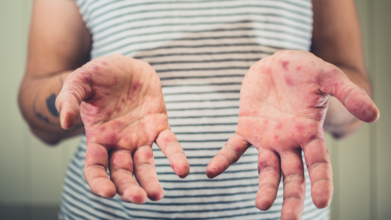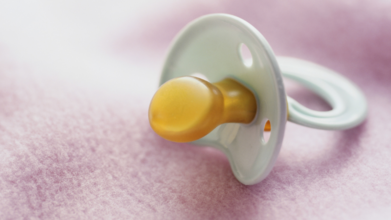- Health Conditions A-Z
- Health & Wellness
- Nutrition
- Fitness
- Health News
- Ayurveda
- Videos
- Medicine A-Z
- Parenting
- Web Stories
Measles In US: What Is The First Symptom Of Measles And How To Recognize It?

(Credit-Canva)
As measles cases surge in the US, many people are worried about how the disease might affect them and how to stay safe. In an official statement, CDC Clinical Outreach and Community Activity (COCA) states how US has recorded record-breaking numbers of measles cases, despite it being declared eliminated in 2000.
Measles is one of the most infectious diseases to exist, and even if it may not affect adults too much it could have a fatal effect on children.
Outbreaks have been recorded in areas that have low vaccination coverage. To understand and suggest better ways to mitigate this threat COCA has organized a call that will answer questions related to “preventing, identifying, and testing for measles.”
Amid this health crisis, one must know how to identify early signs and symptoms of the disease for better care.
What Are The First Signs of Measles Infection?
Measles is a serious and highly contagious illness that can be particularly dangerous for babies and young children. The best way to prevent measles is to get vaccinated. The measles, mumps, and rubella (MMR) vaccine is a safe and effective way to protect yourself and others from this dangerous disease. It's more than just a simple rash and can lead to severe health problems, and in some cases, death.,
First Signs of Trouble
The first signs of measles often mimic a common cold. These initial symptoms include a high fever that can reach over 104°F, a persistent cough, a runny nose, and red, watery eyes. These symptoms can be misleading, but their combination is a key indicator of the onset of measles.
Koplik Spots
A distinctive sign of measles are the of tiny white spots, called Koplik spots, inside the mouth. These spots typically develop two to three days after the initial symptoms begin. Their presence is an important diagnostic clue, often appearing before the characteristic measles rash.
What Does A Measles Rash Look Like?
A rash appears three to five days after the initial symptoms. It usually starts as flat red spots on the face, near the hairline, and then spreads downward to the neck, trunk, arms, legs, and feet. The spots can sometimes be slightly raised and may merge together. When the rash appears, the fever may also increase significantly.
Who is Most at Risk?
While measles can be serious for anyone, certain groups are at a higher risk of developing complications. These include:
- Children younger than 5 years old
- Adults older than 20 years old
- Pregnant women
- People with weakened immune systems due to conditions like leukemia or HIV
What Are Some Serious Complications Caused By Measles?
Measles can lead to several severe complications, especially in young children and adults.
Pneumonia
This lung infection is one of the most common causes of death from measles in young children, affecting as many as 1 in 20 children with the disease.
Encephalitis
About 1 in 1,000 children with measles will develop encephalitis, a dangerous swelling of the brain. This can cause convulsions and may result in deafness or intellectual disability.
Hospitalization and Death
About 1 in 5 unvaccinated people in the U.S. who get measles are hospitalized. In severe cases, 1 to 3 of every 1,000 children who are infected with measles will die from complications.
Pregnancy Risks
For pregnant women, measles can lead to a premature birth or a low-birth-weight baby.
Long-Term Effects
Even after a person recovers from measles, there is a small risk of a rare but fatal long-term complication called subacute sclerosing panencephalitis (SSPE). SSPE is a disease of the central nervous system that can develop 7 to 10 years after a measles infection, even if the person seemed to have fully recovered. The risk of developing SSPE may be higher for children who get measles before the age of 2.
What Is Mermaiding? The Aquatic Fitness Trend Taking the Internet by Storm

Mermaiding wellness? What on Earth is that? It is neither a myth nor a resort spa gimmick. It is a full-on wellness trend that has taken the watersports world by storm. At its core, mermaiding wellness is the practice of donning a mermaid or merman tail and swimming or lounging in water while embodying that mermaid-inspired persona. The magic starts with the tail itself. Many are made of soft silicone that feels smooth against your skin and moves fluidly in water. Others are crafted from stretchy fabrics that cling and stretch as you swim.
Why is it trending?
Essentially, it is wellness with fun. The water becomes more than a workout space; it becomes a fantasy realm. A mermaiding session goes beyond a lap swim and becomes a mythical adventure. Imagining yourself gliding under coral castles or playing tag with fish brings joy and absurdity into your routine. That joy releases endorphins and makes movement feel like play rather than performance.
Mermaiding also ticks many boxes people look for in wellness: stress relief, mindfulness, muscle elongation from undulating movements, cardiovascular fitness from kicking, and creative expression through tail design and movement. It is a head-to-toe engagement that feels more like a ritual than a workout.
The practical side
Of course, safety and practicalities come into play. Swimming with a monofin inside a tail requires instruction. Sessions often begin with a tutorial on marine-like movement, body positioning, and the specific technique of flipping the tail for propulsion. You learn to breathe calmly, keep movements smooth, and roll safely to the side if you need to breathe mid-stroke. You also learn to surface gently, avoiding broken tails or flailing arms, and to develop a unique spatial awareness in the water.
Mindfulness with a splash
Many mermaiding studios and retreats combine tail time with mindfulness practices. Breathwork, visualisation, and guided relaxation often happen poolside before diving in. Instructors might encourage you to imagine swimming through a kelp forest or watching schools of shimmering fish glide past. This imagery lets your mind release everyday stress and connect more deeply to movement.
A community under the sea
Mermaiding wellness events often evolve into community rituals. Think “mermaid circles” in calm pools, where participants gather to chat, share their favourite sea creature, or tell their first ocean memory. These micro-rituals weave connection, celebration, and water sense into a shared wellbeing experience.
Style and sparkle
Mer tails come in every possible colour and pattern. You might choose tropical scales in hot pink, violet, and blue, or a silver shimmer that glows under pool lights. Mermen might go for deep ocean teal with pearl accents. Accessories, from seashell bracelets to starfish hair clips, complete the look. Some people even add water-safe face paint or blinking LED lights for extra magic. It is not about perfection; it is about joy, glitter, and a touch of make-believe.
Why Now?
The rise of immersive, playful movement trends has paved the way for mermaiding. It taps into childhood nostalgia, the human pull toward the ocean, creative self-expression, and community. It offers something refreshingly different from the gym or yoga mat: a chance to feel both meditative and mischievous.
Taking the plunge
Mermaiding would not replace running or yoga, but it offers something wonderfully unique. It invites you to move mindfully, with humour, sparkle, and community magic. You will leave the water not just with damp hair but with the feeling of having lived a tide-touched daydream.
If you are tempted to try it, search for local mermaiding classes or retreats. Most beginners’ sessions include tail rental and instruction. All you need is a swimsuit, a towel, and the willingness to make a splash in a mythical way.
‘It Feels Like The Safety Of Childhood’: Why Adult Pacifiers In China Are Helping People Quit Smoking, Sleep Better And Stress Less?

Credits: Canva
In China, a new trend is reshaping adult coping culture and it’s not herbal tea, meditation apps, or plush toys. It’s adult-sized pacifiers. Once the domain of babies, these silicone soothers have found a surprising audience among stressed-out grown-ups looking for calm, better sleep, or even help quitting smoking.
Available on platforms like Taobao and JD.com for as little as 10 yuan ($1.40) and as much as 500 yuan ($70), they’re marketed with a wellness twist: stress relievers, sleep aids, even bite guards to prevent teeth grinding. Some users swear they help curb late-night snacking or silence a snoring partner. And they’re selling fast! According to South China Morning Post, top vendors are moving thousands every month.
The phenomenon has exploded on Chinese social media. On Sina Weibo, hashtags related to “adult pacifiers” have racked up over 68 million views. Douyin (China’s TikTok) is packed with short videos of young people unboxing, testing, and explaining why they’ve embraced the trend. The most popular pacifiers measure 4.5 centimeters—nearly twice the size of those for infants—and are designed for adult mouths.
For some, it’s about breaking a habit. A Douyin user credited the pacifier with stopping her constant snacking, claiming it even helped with weight loss. Another posted that it helped her finally quit smoking after years of failed attempts. Many describe the sensation as instantly calming, a tactile anchor in a chaotic day.
Is This A Use Of Regression As A Coping Mechanism?
Psychologists point to the “regression phenomenon” to explain why this works for some. When stress overwhelms, people may subconsciously revert to behaviors from an earlier, more secure stage of life. In infancy, sucking is a natural source of comfort and self-soothing. For adults, the pacifier becomes a symbolic return to a time without deadlines, bills, or complex emotional burdens.
“It feels like the safety of childhood,” one office worker wrote in an online review. That feeling can be powerful—especially in high-pressure work environments where people struggle to find moments of rest.
Is Any Medical Caution Needed?
Not everyone is convinced this is harmless. Dentists like Tang Caomin warn that prolonged use can shift teeth, limit jaw movement, and cause temporomandibular joint (TMJ) issues. There’s also a risk of sleep disruption or choking if parts come loose during the night. Wang Xueling, director of stomatology at the Aerospace Center Hospital in Beijing, notes that while pacifiers can offer temporary emotional relief, they don’t address the underlying causes of stress.
Psychologist Zhang Mo is more direct: “The real solution is not to treat yourself as a child, but to face the challenge directly.”
This isn’t staying in China. On TikTok, American users have begun posting clips of themselves with adult pacifiers—in traffic, at work, or during intense moments of burnout. Some claim it helps with ADHD-related restlessness, while others admit it’s simply a private comfort they’ve used for years.
A commenter averred to having used pacifiers for 23 years, and another dismissed worries about dental effect: "It hasn't moved my teeth, been using them for 4 years." Nevertheless, critics propose alternatives such as chewing gum or lollipops to meet the same oral fixation without risking dental damage.
It's not just an object that the adult pacifier trend represents; it is what the object stands for. In the face of economic insecurity, social pressure, and constant digital overstimulation, small rituals that give control or comfort can become very attractive. For many, this has been a private rebellion against relentless productivity culture, reminding them that it's okay to need comfort-even if it looks unconventional.
Why Adults Are Reaching for Pacifiers?
The oral fixation and emotional regression psychology lies at the root of this phenomenon. Psychoanalytic theory has it that in the course of human development, the oral stage marks the earliest point. This is where sucking, eating, and all else related to the mouth takes precedence for comfort and bonding purposes. When adults experience stress beyond their coping ability, they may respond unconsciously by regressing to behaviors associated with this stage—behaviors that once consistently brought feelings of safety.
In today's language, this is a type of "self-soothing." Similar to chewing on a pen cap, biting one's nails, or drinking from a straw, pacifier use involves sensory pathways that quiet the nervous system. The rhythmic, repetitive motion can relax breathing, decelerate heart rate, and generate an inconspicuous feedback loop that communicates relaxation to the brain.
But there's an important difference between temporary relief and addiction. Whereas brief use may alleviate anxiety or cut addictive habits like smoking, heavy reliance on such aids can cover up underlying problems—long-term stress, sleep disorders, unresolved emotional trauma—that need more engaged solutions. Therapists warn that such behaviors are better understood as adjunctive coping strategies, not substitutes for solving core issues.
That is, the pacifier can get you through a long commute or a stressful meeting. But it won't address the situation that's causing you to need one in the first place. The true test—and challenge—are in figuring out how to introduce some of that same sense of security into your life without resorting to a silicone substitute.
When to Worry About Heart Palpitations: How to Tell If That Racing or Skipping Beat Is Just Stress or a Medical Warning

You know that strange moment when your heart feels like it’s suddenly skipping beats? Whether it’s a rapid thud-thud-thud or a flutter that makes you freeze mid-sentence, heart palpitations can be unsettling. But are they always bad news? According to experts, not necessarily, but they’re not to be brushed aside either.
What exactly are heart palpitations?
As Dr Bipeenchandra Bhamre, Consultant Cardiac Surgeon at Sir H. N. Reliance Foundation Hospital and Research Centre in Mumbai, explains, palpitations are feelings where your heart tends to pound, flutter, or beat too fast or irregularly. You might feel them in your chest, throat, or even neck. They can show up while you’re lounging on the sofa or right after an intense workout.
Causes? Oh, the list is long. Stress, anxiety, too much caffeine, alcohol, dehydration, fever, hormonal changes, certain medications — the usual suspects. But Dr Bhamre warns that in some cases, they can be linked to more serious conditions like thyroid problems, heart rhythm disorders (arrhythmias), or even heart disease. “If you experience chest pain, dizziness, or shortness of breath along with palpitations, it’s time to get checked without delay,” he says.
When it’s probably harmless
If you’re otherwise healthy and your palpitations pop up only occasionally, chances are they’ll pass on their own. Dr Bhamre notes that most healthy people experience them now and then, often triggered by lifestyle factors. Your morning triple espresso, your boss’s 4 p.m. email bombshell, or that late-night Netflix thriller might be to blame.
Dr Swarup Swaraj Pal, Chief CVTS Surgeon at Gleneagles Hospital, Parel, Mumbai, adds that palpitations are common in a large number of people and, most of the time, cause no harm. “They’re often just your body’s way of saying it needs a break — maybe from caffeine, maybe from stress, maybe from your phone at 1 a.m.,” he says.
When to treat them as a health alarm
Here’s the rule: if palpitations are frequent, last longer than a few seconds, or arrive with bonus symptoms like chest pain, fainting, or severe breathlessness, they could be a sign of something more serious. That’s when you call your doctor and schedule a check-up, pronto.
Dr Pal advises keeping an eye out for patterns. “Notice if they happen after your third coffee, a heated argument, or intense exercise. Even drug abuse can trigger palpitations,” he warns. Understanding your personal triggers can help your doctor pinpoint the cause.
Palpitation diary
Both experts suggest tracking your symptoms. Note down:
How often they happen
How long they last
What you were doing or feeling right before they started
It’s not about obsessing over every heartbeat, but about giving your doctor clues. This “heartbeat log” could save you unnecessary anxiety — or, in some cases, catch an issue early.
Lifestyle tweaks that can help
According to Dr Bhamre, some small adjustments can make a big difference:
Cut back on caffeine, energy drinks, and alcohol
Stay hydrated — dehydration can worsen palpitations
De-stress — try yoga, meditation, deep breathing, or a walk without your phone
Get enough rest — lack of sleep can mess with your heart rhythm.
Dr Pal also suggests managing anxiety with calming techniques. “Sometimes, simply calming yourself down can reduce palpitations triggered by stress,” he says.
Why ignoring your heart is a bad idea
Your heart might be small compared to, say, your ego when you win a board game, but it’s literally keeping you alive. As Dr Bhamre reminds us, “Don’t take your heart health lightly at all.” Early evaluation and lifestyle changes can keep a minor flutter from turning into a major crisis.
© 2024 Bennett, Coleman & Company Limited

